#yariume
Photo



Graphic black and striking yellow for this tachibai (plum blossom branches raising straight for the sky) patterned kimono
167 notes
·
View notes
Photo

. KUON|Tyvek Coat|White 建築資材であるタイベックに、日本特有の柄である槍梅柄をプリントし、スプリングコートに仕上げています。防水・透湿長けているので、梅雨時期はもちろん、アウトドアで着ても面白いと思います。 . ■KUON■ KUON(クオン)は日本語の「久遠」、「遠い過去または未来」「永遠」に由来しています。世界中に存在する古着や古布の持つ歴史や文化を取り入れながらも、その枠に捉われず、時代が巡っても変わらない、理屈抜きのシンプルなカッコよさを追求することをブランドの真髄としています。「新しいものは古くなるけれど美しいものはいつまでも美しい」 . ✔︎#KUON ✔︎#madeinjapan ✔︎#Tyvek ✔︎#yariume ✔��#Coat ✔︎#クオン ✔︎#日本製 ✔︎#タイベック ✔︎#コート ✔︎#防水 ✔︎#透湿 ✔︎#建築資材 . DIARIES 〒305-0031 茨城県つくば市吾妻3-8-17 TEL:029-875-7754 12:00-20:00 (木曜定休・その他) https://diaries-shop.com #diaries #tsukuba #ibaraki #japan #ダイアリーズ #つくば #茨城 #日本 #セレクトショップ (Diaries(セレクトショップ@つくば)) https://www.instagram.com/p/BuIY13HnPY5/?utm_source=ig_tumblr_share&igshid=1qny4sv4jsnmv
#kuon#madeinjapan#tyvek#yariume#coat#クオン#日本製#タイベック#コート#防水#透湿#建築資材#diaries#tsukuba#ibaraki#japan#ダイアリーズ#つくば#茨城#日本#セレクトショップ
1 note
·
View note
Photo

Tea caddy, named Yariume (”Plum Branch”)
Japanese (from the Uchigaso kiln in Nogata, Fukuoka prefecture), Edo Period, 1614-1624
stoneware with iron and rice-straw-ash glazes, and ivory lid
Freer Gallery of Art
#tea#tea ceremony#tea caddy#pottery#ceramics#Japan#Japanese#Japanese art#Edo Period#Uchigaso kiln#Nogata#Fukuoka#stoneware#ceramic#Takatori ware#Freer Gallery of Art#Freer Gallery#Freer Sackler#art#Asian art
8 notes
·
View notes
Photo


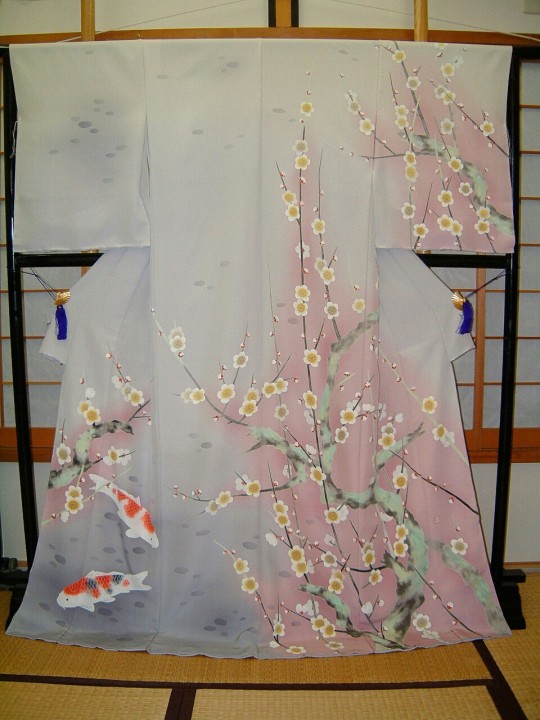

Fantastic yuuzen-dyed houmongi made for a young craftsmen contest hold in 2007 & 2008 by now yuuzen artist Uenaka Masashige.
First one entitled “Spring fragrance” depicts sakura tree in full bloom beneath a suggested temple roof. Second one is “plum-viewing carps” showing koi in a pond seeming to admire yariume/“spear plums” (or tachibai/“rising plums”)
#japan#fashion#kimono#houmongi#yuuzenzome#yuuzen#sakura#cherry blossom#ume#plum blossom#koi#koi carp#carp#yariume#tachibai#着物#帯
164 notes
·
View notes
Photo
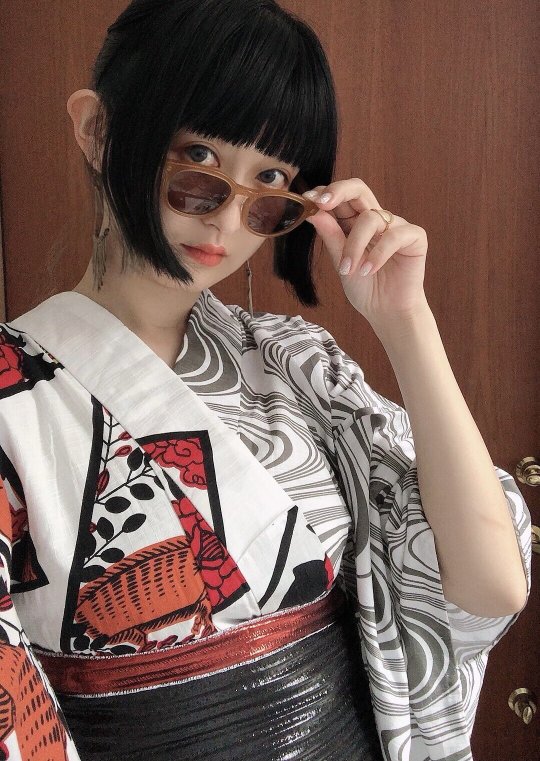
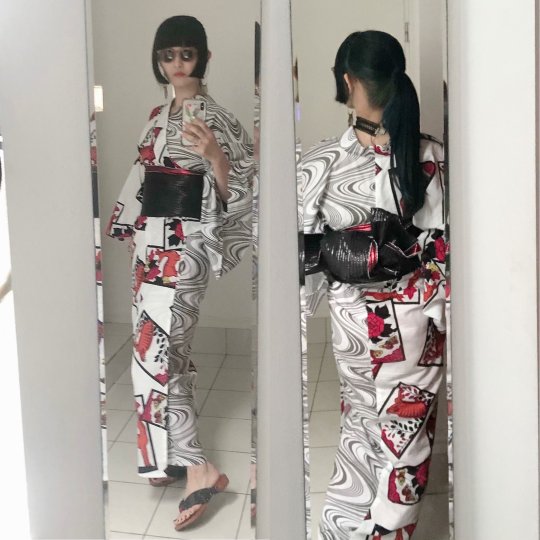
Super cool hanafuda (”flower cards”) + ryuusui (stream) yukata (seen on), paired with a Rumirock obi.
I believe I’ve never touched Hanafuda cards here, so buckle up for a long post ;)

Hanafuda is a card game with 12 different suits of 4 cards. Each suit is linked to a lunar month through symbols, all inspired by classical culture (months where later matched to Western calendar hence why some symbols seem off).
Please note that in the list below, I’ll use ‘meaning’ in the broad sense as following symbols often have many overlaping significations:
睦月 Mutsuki (1st lunar month) / January
=> Symbols: matsu (pine), tsuru (crane), hi (sun), ‘akayoroshi’ tanzaku (paper strip, with auspicious あ(か)よろし meaning lit. ‘red is good’ = ‘really wonderful’)
=> Meaning: eternity, happy/new beginnings as January is the New year month

如月 Kisaragi (2nd lunar month) / February
=> Symbols: ume (plum blossoms), uguisu (bush warbler), ‘akayoroshi’ tanzaku (paper strip, with auspicious あ(か)よろし lit. ‘red is good’ = ‘really wonderful’)
=> Meaning: beginning of spring, well read people (especially refers to Michizane/Tenjin), a match made in heaven
As a side note, plum branches rising to the sky is an auspicious motif known as yariume/“spear plums” or tachibai/“rising plums
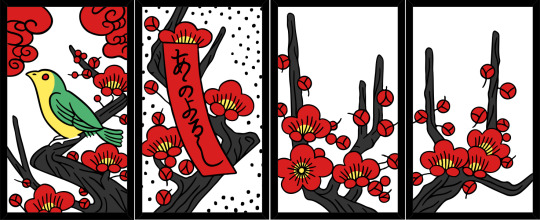
弥生 Yayoi (3rd lunar month) / March
=> Symbols: sakura (cherry blossoms), hanamimaku (curtain, here cherry blossoms viewing parties), ‘Miyoshino” tanzaku (paper strip, Yoshino is a place famous for its sakura)
=> Meaning: beautiful yet fleeting life (like the delicate sakura blossoms)

卯月 Uzuki (4th lunar month) / April
=> Symbols: fuji (wisteria), hototogisu (cuckoo), red tanzaku (paper strip)
=> Meaning: coming of summer, beautiful yet fleeting life (cuckoo sometimes symbolize mourning souls). Fuji could also refers to famous episodes of the Tale of Genji.
As a side note, cuckoo also stands for patience in Japan, probably because of the zen charade known as “If the bird doesn’t sing..”

皐月Satsuki (5th lunar month) / May
=> Symbols: kakitsubata (iris), yatsuhashi (zigzag bridge), red tanzaku (paper strip)
=> Meaning: deep and nostalgic love, inspired by famous poetical scenery from the Tales of Ise (motif is present in many paintings like this screen by Korin). Iris are also a symbol of strenght as seen in Tango no sekku festival
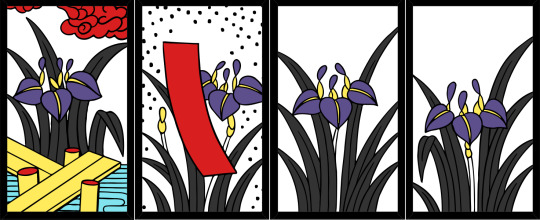
水無月 Minazuki (6th lunar month) / June
=> Symbols: botan (peony), cho (butterfly), purple tanzaku (paper strip)
=> Meaning: road to heaven (symbols came be found in noh piece ‘Shakkyo’ and Kabuki one ‘Kagamijishi’), butterflies often stand as a symbol for spirits or souls

文月 Fumizuki (7th lunar month) / July
=> Symbols: hagi (clover), shishi/inoshishi (boar), red tanzaku (paper strip)
=> Meaning: coming of autumn, the strong needing the meek (a variation of tiger in the bamboo grove motif)

葉月 Hazuki (8th lunar month) / August
=> Symbols: susuki (pampa grass), kari (wild geese), full moon (meigestu)
=> Meaning: moon/harvest festival (tsukimi), deep nostalgia as year goes by (nature will soon be asleep as winter will follow autumn)

長月 Nagatsuki (9th lunar month) / September
=> Symbols: kiku (chrysanthemum), sakazuki (sake cup, with kotobuki/‘long life’ kanji), purple tanzaku (paper strip)
=> Meaning: long life, immortality. In ancient japan, it was customary to drink chrysanthmum wine during Chouyou no en festival as a wish for long life (people also used to drink/use as medicine dew collected on mums leaves and flowers). As a side note, objets flowing in a stream (like sake cups) were once used as timer during poetry competitions.

神無月 Kannazuki (10th lunar month) / October
=> Symbols: momiji (maple), shika (deer)
=> Meaning: momijigari (hanami autumn twin) parties and as March card = beautiful yet fleeting life. Shika deers also have deep auspicious connotation as they are messengers of the gods in Shinto
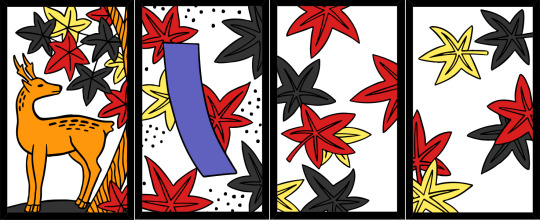
霜月 Shimotsuki (11th lunar month) / November
=> Symbols: yanagi (willow), Ono no Michikaze and a frog, tsubame (swallow), Inazuma (thunder, wildcard sometimes bare and nicknamed “onifuda”/demon card)
=> Meaning: this card is always the most puzzling one for me, as in kimono fashion yanagi+tsubame are not truly a November motifs ^^;
But here, the most important symbol (most often only present as an umbrella!) is a driving rain under which willows dance. Poet Ono no Michikaze, walking by a riverside in that awful weather, spots a struggling frog. After many efforts, the frog finally succeeds jumping in a willow - inspiring Michikaze. This suits hence symbolizes diligence and determination.
As a side note, nure tsubame (lit. “wet sparrows”) symbolize lovers - especially star-crossed ones

師走 Shiwasu (12th lunar month) / December
=> Symbols: kiri (paulownia), houou (phoenix)
=> Meaning: longevity, life circle (“beginning to the end”), power. Legends say phoenix can only nest in paulownia trees

I won’t go into details as to how to play with hanafuda as 1) I am terrible with cards games, and 2) I learned koi-koi rules only thanks to the Ryu ga gotoku/Yakuza video games xD (amazing game serie, if you don’t know about them, go play!!! They have been re-released not long ago)
#japan#fashion#kimono#yukata#hanafuda#card game#cards#lunar month#matsu#tsuru#akayoroshi#tanzaku#uguisu#ume#yariume#tachibai#maku#hanamimaku#Yoshino#sakura#fuji#hototogisu#kakitsubata#ayame#Korin#botan#cho#Shakkyo#Kagamijishi#hagi
596 notes
·
View notes
Photo

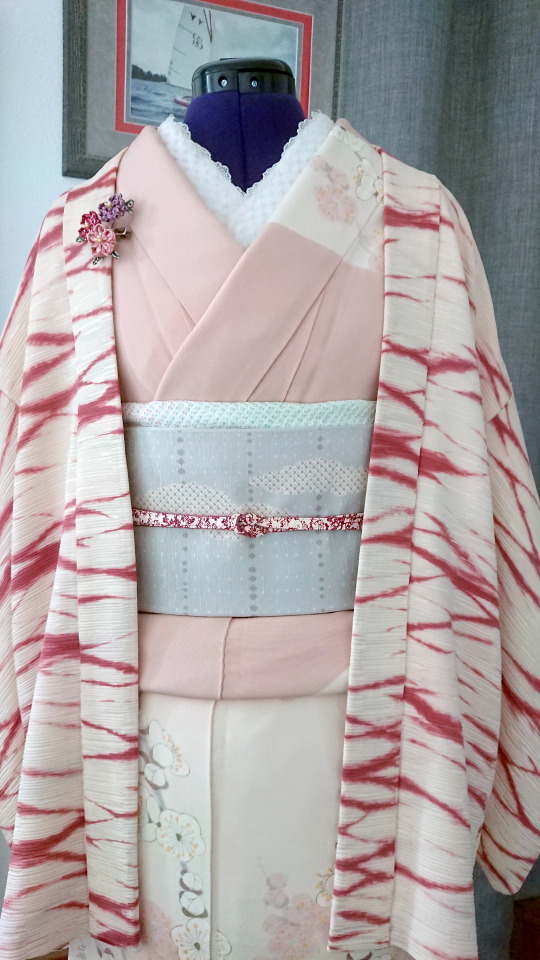



To celebrate our snowy winter + my coming birthday + February monthly flower (plum blossoms!), I’ve decided to style one of my beloved houmongi. This outfit is much sweeter than what I am used to, but I think it works?
This kimono has a naturalist pattern of plum tree branches with blossoms rising to the sky (called in Japanese yariume/"spear plums" or tachibai/"rising plums"). I paired it with my kitsune no yomeiri (fox wedding) obi, and a matching soft gradient shibori obiage.
Some zest was then added with my murakumo* shibori haori, a fake leather obijime, some lace used as haneri, and my ume hairpin (made by @wisteriagardens).
*murakumo shibori is made by tying fabric around a pole, which gives those wave like stripes:

(pic from this handy visual catalogue)
#japan#fashion#kimono#obi#personal#kitsuke#ume#yariume#tachibai#plum blossom#kitsune#kitsune no yomeiri#fox#fox wedding procession#shibori#haori#murakumo shibori#着物#帯#羽織
503 notes
·
View notes